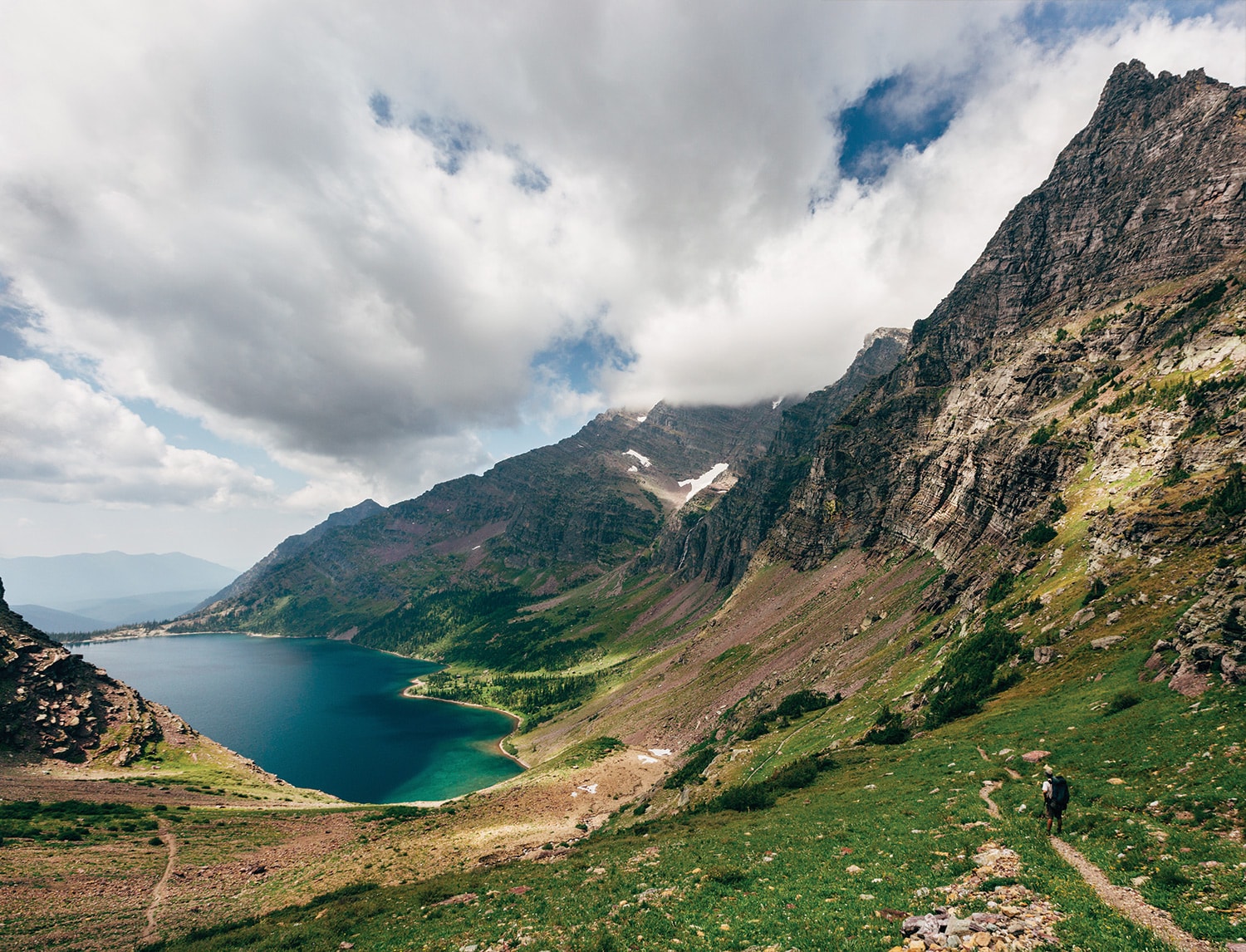
08 Feb Sperry Elegy
THUNDER BOOMED AND LIGHTNING STRUCK the valley below. Rain strafed the exposed granite ridge in windy gyres, but only briefly. Remnant water drops glinted on the chalet windows — fool’s gold in the setting sun — and a deceptive rainbow appeared to the west over Lake McDonald. The storm seemingly had passed.
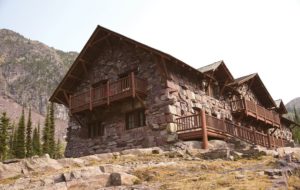
For over a century, Sperry Chalet anchored a rocky ridge more than 3,300 vertical feet above Lake McDonald. Photo by Jeff Erickson
Hiking compadre Mary and I observed this spectacle from the communal dining room at Glacier National Park’s iconic Sperry Chalet, sharing a table with other couples who had made pilgrimages here from as far as Tokyo. We shared plans for the next day: Our scheme was to hike to Lake Ellen Wilson and fly fish for orange-bellied brookies. It was a tough call, because walking to the spectacular Sperry Glacier was exerting its own gravitational pull. But we thought we’d have plenty of time to rest and leisurely explore.
Tough Trek to Sperry
“How would you two like a cold glass of lemonade?” a motherly chalet employee had welcomed us earlier that day.
Mary and I sloughed off our packs, hobbled into the kitchen, and slumped at a table like sweat-drenched, beaten dogs. Mary’s fine, long blond hair was morphing into thick dreadlocks. In the afternoon heat, we had slowly wound 6.7 miles and 3,300 vertical feet up the mountain from the Lake McDonald Lodge, cresting in a glacial cirque at an elevation of 6,560 feet. In my 20s, I had scampered up switchbacks like a gazelle, but those days were gone.
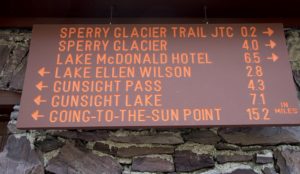
Sperry was a paradise for hikers, and a cozy base for exploring spectacular backcountry trails. Photo by Jeff Erickson
Visitors don’t usually just wash up at Sperry serendipitously. You have to make a concerted effort to get there, even beyond the hike. Success demands calling or going online when the reservation starting-gun goes off months before. If you don’t get right on it, you’re out of luck, aced-out by savvy sojourners from Berlin, Boston, or Billings. But in 2017, our number finally came up for prime-season nights at Sperry, beginning August 10.
There’s justification for this keen interest. The historic chalet perches amid an alpine paradise of glaciers, cascades, and turquoise lakes, populated by curious marmots, mountain goats, and grizzly bears. The chalet opened in 1914, part of the Great Northern Railroad’s efforts to attract visitors via its Northern Montana trains. For decades, this rustic rock and wood outpost has been a beloved sanctuary for hikers.
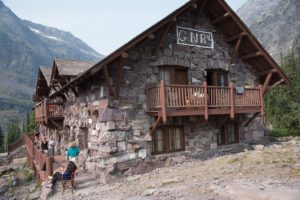
The decks at Sperry Chalet offered places for relaxing, socializing, and enjoying unparalleled vistas. The chalet was originally built by the Great Northern Railroad to help attract tourists to the area. Photo by Jeff Erickson
The concept was based more on Swiss Alps chalets than on traditional Rocky Mountain backcountry travel. Originally, there was a network of nine Glacier wilderness chalets, but with the erosive power of time they gradually dwindled to two, the other being the primitive Granite Park Chalet. Sperry lodgers got shelter, a bed, and hearty meals, negating the need to carry much gear. But the chalet retained a primitive ambiance: Rooms lacked heat, electricity, and running water, while supplies were packed in by horse or mule. The only access was either via the trail we came in on up Sprague Creek or the grueling 13.7-mile climb over Gunsight Pass and the Continental Divide. And we weren’t up for that.
Long Night into Hazy Zay
After dinner, contented guests dispersed, some lingering on the chalet decks with glasses of wine that had been packed in, watching the storm break apart. As it grew dark, we heard some commotion outside our room and went to investigate. Indefatigable chalet manager Renee Noffke huddled up lodgers like a quarterback. We learned that park officials had just informed her that one of the 150-plus lightning strikes hitting Glacier that day had started a forest fire several miles below us near Sprague Creek: “You should start packing and be ready to evacuate over Gunsight Pass,” she told us. “I think we’ll probably be OK tonight, but we’ll see.”
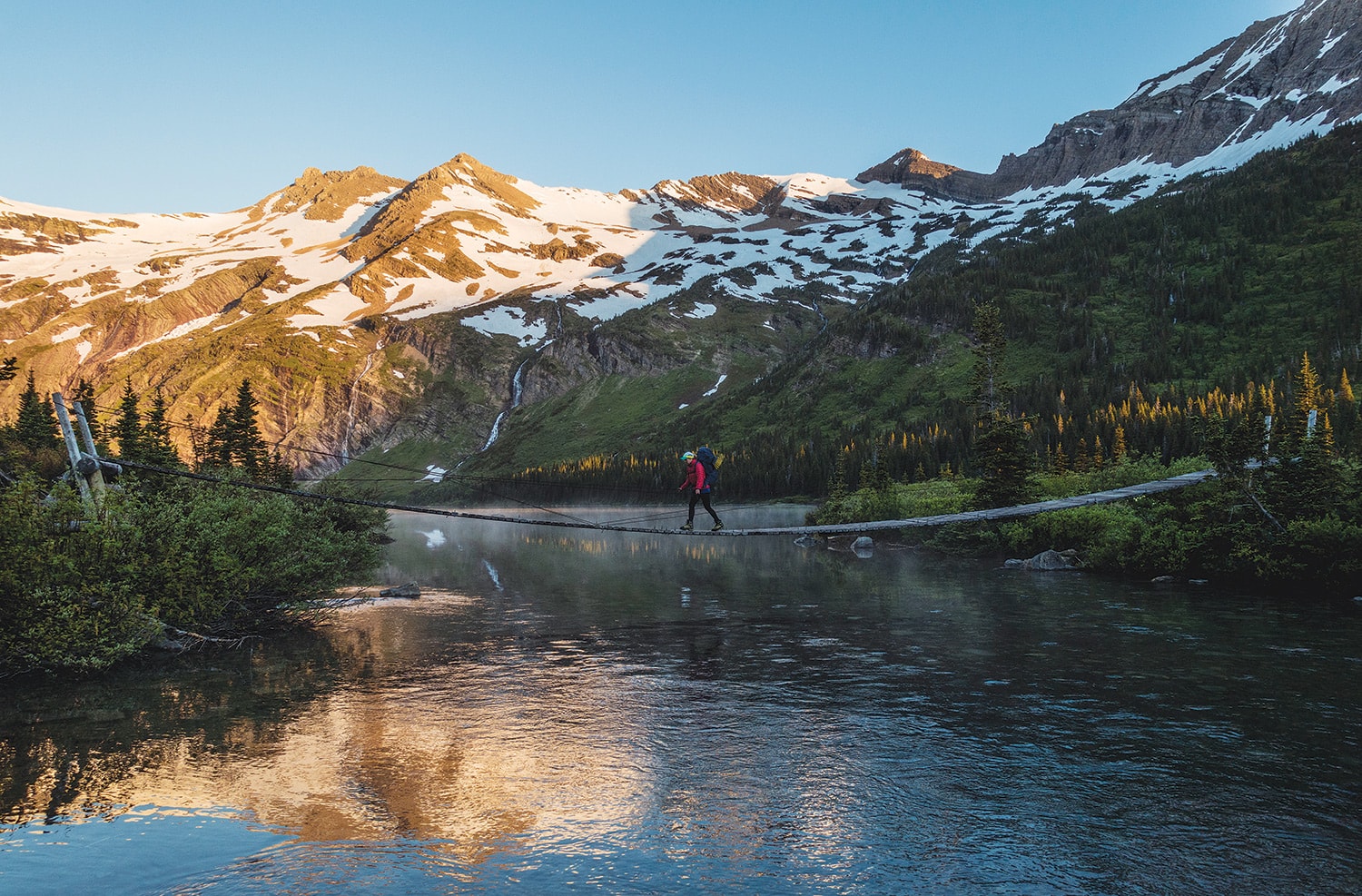 Part of the 13.7-mile evacuation route for those who spent the final night at Sperry was over this foot bridge on the upper Saint Mary’s River. Photo by Glacier National Park
Part of the 13.7-mile evacuation route for those who spent the final night at Sperry was over this foot bridge on the upper Saint Mary’s River. Photo by Glacier National Park
It was a long, sleepless night spent tossing, turning, and wondering. I imagined dawn would bring the sound of tankers and buzzing helicopters, quickly beating down the fire. “Everything will be fine,” whispered the diminishing, Pollyannaish portion of my mind. Hopefully I’d soon be casting to Lake Ellen Wilson risers.
But daybreak was eerily calm and silent; there was no sign of the imagined aerial assault. Crews and equipment were spread thin across the burning West. Far below, thick smoke gradually crept up the mountain. When everyone anxiously gathered for breakfast, Noffke briefed us with the calm of a mountain Buddha: “I’m not going to tell anyone what to do, but I would urge everyone who’s able to hike out over Gunsight today.” Park officials couldn’t predict the blaze’s behavior. The easiest exit along Sprague Creek was closed by the fire. There was no emergency evacuation plan yet; presumably anyone not able to hike Gunsight would be carted out by chopper or horse.
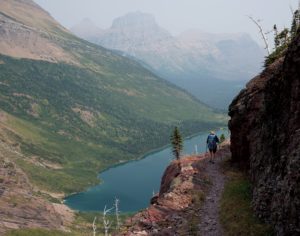
The author’s wife, Mary Vandenbosch, hikes out from Sperry along the Gunsight Trail, dropping precariously down to its namesake lake. Photo by Jeff Erickson
After deliberations, virtually all of the 40-plus guests decided to make the hike, with varying amounts of enthusiasm. There was concern and disappointment, but no panic. I was one of the last holdouts, naively hoping the fire would be extinguished; the thought of hiking twice as far as yesterday was demoralizing. But with Mary’s reality-based lobbying, I came around.
Walking back to our room, I ran into a park employee working on the water system. When I told him we planned on hiking out over Gunsight — after I put on sunscreen — he was candid: “See that smoke coming up here? I’d forget the sunscreen and leave now!”
And that’s what we did.
Rising Smoke, Wonderland, Apocalypse
Mary and I were the stragglers, among the last guests to leave Sperry. As we climbed, we were shepherded by mountain goats that seemed to lead the way out. We spiraled down into the massive glacially carved basin holding Lake Ellen Wilson, among the most enticing trout lakes I’d ever seen. But with a long march ahead, there was no time to fish.
Nonetheless, there was a euphoric silver lining: The hike I had been dreading became a magic carpet ride through kaleidoscopic wildflower meadows, glaciers spilling down from mountain tops, and more waterfalls than Shangri-La. Pikas barked from their talus-strewn homes; butterflies and bumblebees floated past. The Gunsight switchbacks seemed endless, but the views rivaled Nepal’s Himalayas. At the top of Gunsight Pass, park employees had posted a sign closing the trail to Sperry-bound hikers.
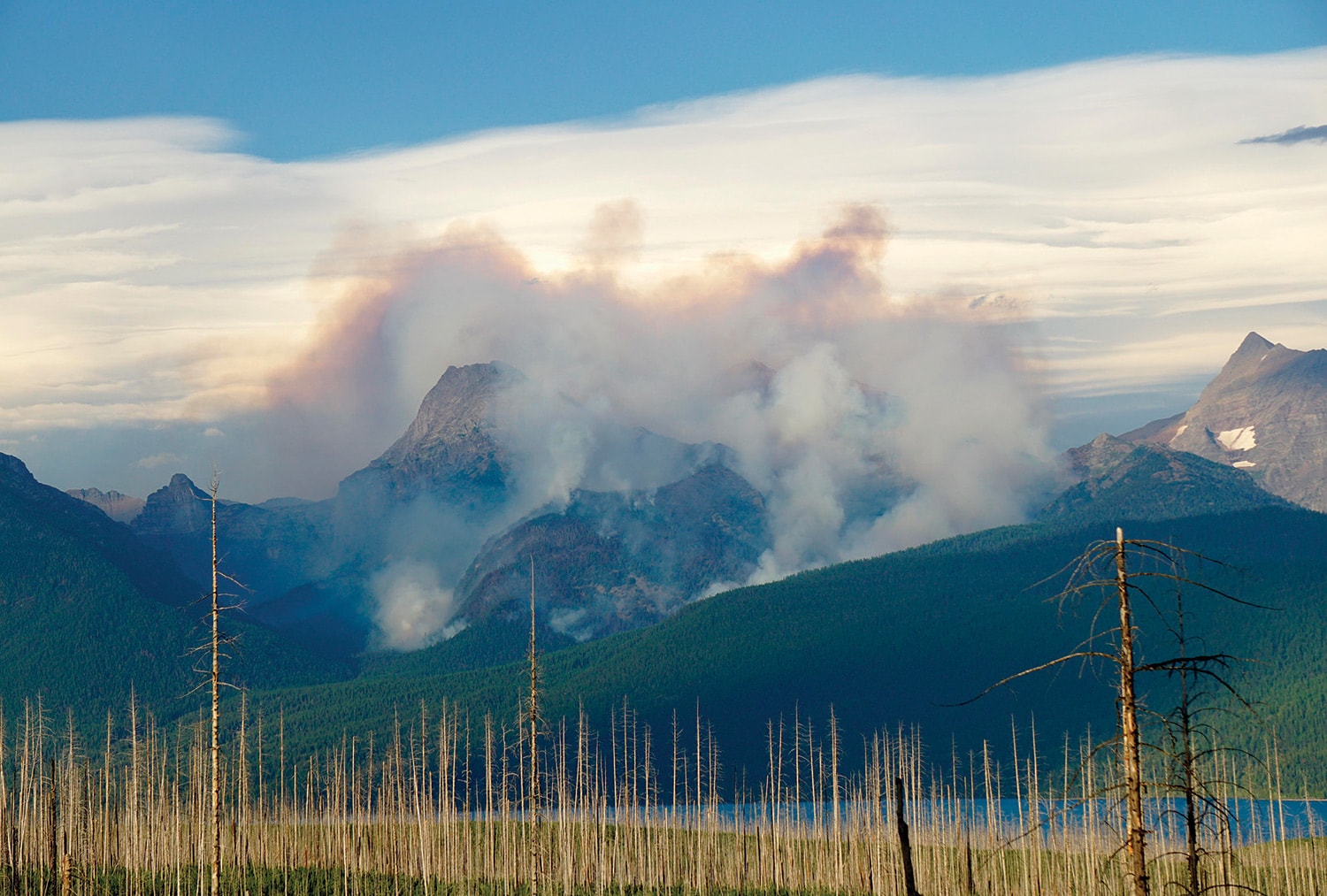 The lightning-sparked, relentlessly expanding Sprague Fire — which eventually burned Sperry Chalet — was visible for weeks during August and September 2017 from the Lake McDonald Valley. The popular Lake McDonald Lodge closed early due to the thick, unhealthy smoke. Photo by Glacier National Park
The lightning-sparked, relentlessly expanding Sprague Fire — which eventually burned Sperry Chalet — was visible for weeks during August and September 2017 from the Lake McDonald Valley. The popular Lake McDonald Lodge closed early due to the thick, unhealthy smoke. Photo by Glacier National Park
Down we went over snowfields and along precipitous cliffs to Gunsight Lake, then the long, tiring trek out to Going-to-the-Sun Highway. Ten hours after starting, I lurched out to the trailhead like a sweat-soaked Frankenstein; there was the promised van, waiting to take us back to Lake McDonald Lodge. We collected other evacuees, and soon had a full load. Everyone made it out safely, exhausted but otherwise no worse for the wear.
We lingered around Lake McDonald the next day, observing helicopters that hoisted enormous water buckets and made repeated runs at the Sprague Fire. But the maelstrom expanded to thousands of acres: At night, ominous orange flames were visible on the mountainside, hungrily licking tree tops as though trying to devour Sperry. And if the winds shifted, even the historic Lake McDonald Lodge far below would be endangered.
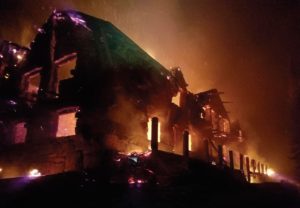
Despite valiant efforts by firefighters, Sperry Chalet was finally lost on August 31. Photo by Glacier National Park
Mary and I didn’t realize it then, but we were among the last hikers to stay at Sperry — there for its final night as a working lodge. After surviving 104 years of blizzards, avalanches, and hurricane-force winds, and despite the efforts of gallant fire crews fighting amid extreme conditions, the battle was finally lost on August 31 when a storm of embers gusted up from the cliff below the complex and landed under the eaves. The venerable chalet’s roof and wooden interior burned down; fortuitously, the stone exoskeleton remained standing. Firefighters held their ground on the mountain overnight, saving auxiliary structures.
Back in 2006, when Noffkee was working her second Sperry summer, she told the Billings Gazette, “It’s very peaceful. … I feel like I could stay here for quite a while and be perfectly content.” She had a long run in nirvana, and perhaps if the chalet rises phoenix-like from its ashes, it will continue. For years, there was a plaque on Sperry’s walls, wisdom from an earlier Sperry manager: “I’ve been here for 30 years now, and no two days have been the same. So while you’re here, pay attention! Whatever happens today — will never happen again.”
Fly Fishing Glacier’s Wild West Side
Glacier National Park’s fly-fishing opportunities might not be as fertile or renowned as Yellowstone’s, but they are worthy fisheries. On the west side of the Continental Divide — the country surrounding Lake McDonald and Sperry Chalet — everything drains into either the North or Middle forks of the Flathead River: fine fisheries and designated national Wild and Scenic rivers. In addition to these beautiful streams and their tributaries, the region is defined by deep, enormous, glacially carved lakes — McDonald, Logging, Quartz, Bowman, and Kintla, to name the largest.
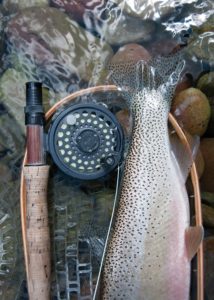
Photo by Jeff Erickson
Native fish in these drainages include westslope cutthroat trout, protected bull trout, and mountain whitefish. During the past century, non-native game fish have been introduced, including brook, lake, rainbow, and Yellowstone cutthroat trout, along with kokanee salmon. A big concern among fisheries biologists are the negative impacts on indigenous bulls and cutts from introduced lakers, rainbows, and other invasive species.
In addition to nearby Lake Ellen Wilson, the main trout fisheries around the Sperry Chalet include the Snyder, Lincoln, and Gunsight lakes just over the Continental Divide. Before September rain and snow finally extinguished it, the Sprague Fire encompassed more than 16,000 acres, and will affect area hiking and fishing options well into the future. Severely burned areas could dump torrents of high runoff carrying silt and ash into Sprague, Snyder, and Lincoln creeks this spring. Snyder Creek flows through the popular Lake McDonald Lodge complex, so that likely will be the area most noticeably impacted. Drainages significantly affected by the fire probably will receive increased nutrient loads, with unpredictable short-term fishery impacts.
Thousands of downed or unstable trees may impede trails, and access could be prohibited to Snyder and Lincoln lakes next summer. Conversely, the Sprague Fire didn’t reach Lake Ellen Wilson or Gunsight Lakes, so those productive waters might still be reached via the Gunsight Pass Trail going southwest from Going-to-the-Sun Highway.
In geological time, and less, impacts from the Sprague Fire will be minimal, although conditions contributing to the fire remain. Anyone visiting Yellowstone in recent years has observed that the park and its fisheries have steadily recovered from the cataclysmic 1988 fires. Over time, fallen trees will create excellent trout cover. Be patient, like nature.
After the Fire
Written by Brian Schott
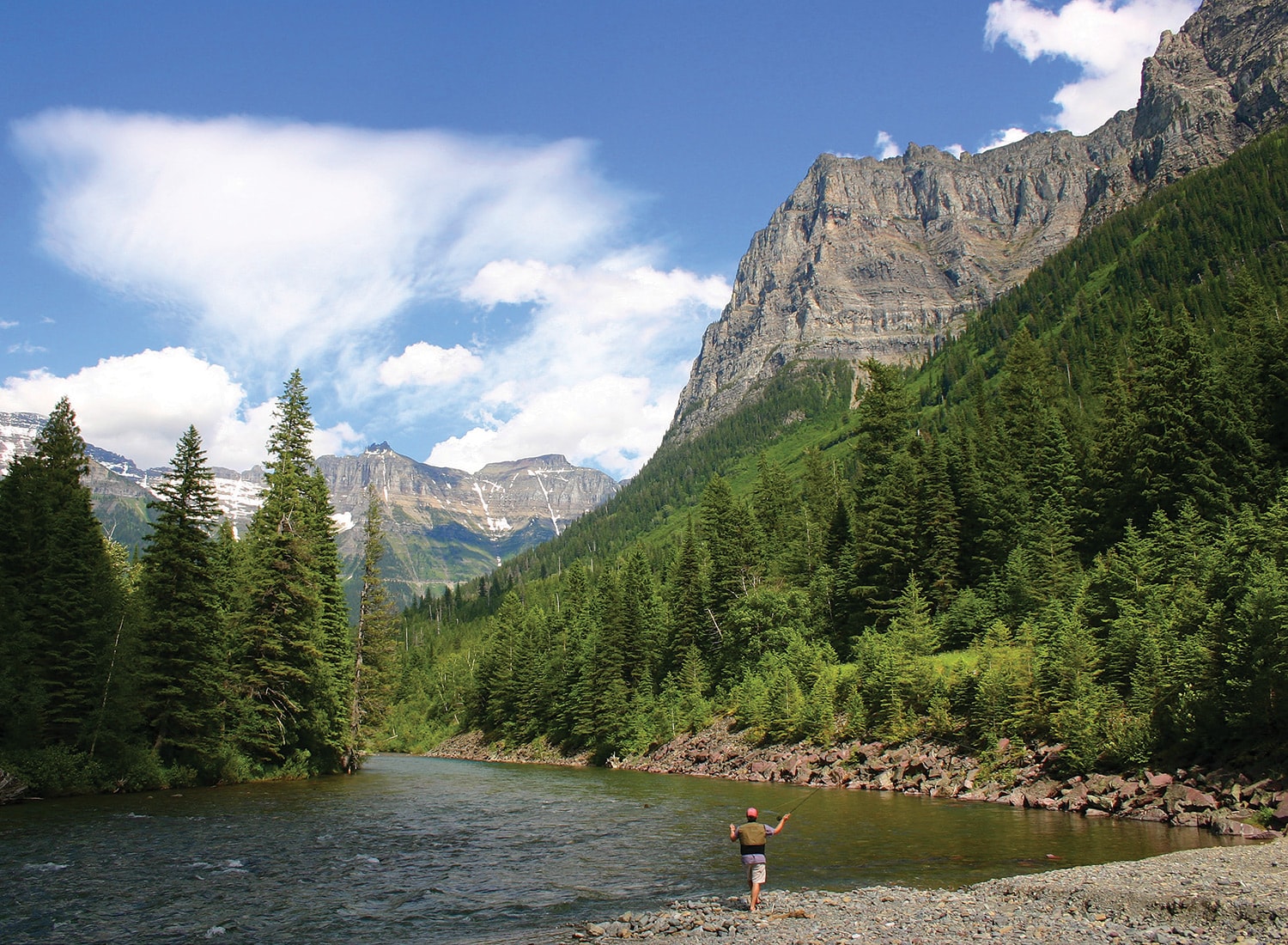
Twenty summers ago, as a young man, I packed my fly rod and jumped on the Sperry Trail in Glacier National Park for my first overnight fishing trip with my girlfriend, Lyndsay. We entered the trail along the flanks of Mount Brown, Lake McDonald shimmering behind us. As we hiked, we passed the fork in the trail that leads to Sperry Chalet and Gunsight Pass. Our destination that morning was Snyder Lakes.
Gaining elevation, the layered, jagged peaks of the mountaintops came into view, reminding me how small we really were. And as we fished that evening, the tiny native trout were so active, and the water so clear, we could watch them advance to our flies.
Over dinner, we sipped wine and noticed an echo after we laughed. We took turns yelling “Ehhh-ko!” and listened to the sound of our voices wrap around the glacial cirque from Mount Brown, to the Little Matterhorn, to the steep cliffs of Mount Edwards.
In the morning, emerging from our tent, thunder cracked in the distance. Somewhere close by, lightning had struck. As rain started to fall, we caught and released the last cutthroat and prepared to return home.
Twenty years later, lightning would strike again.
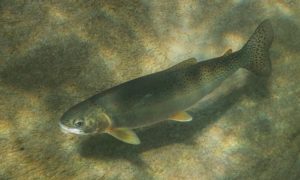
Native cutthroat trout may face challenges from climate change and melting glaciers. Photo by Glacier National Park
Twenty summers. It happens in a blink. I now stand on the shores of Lake McDonald with Lyndsay, my wife. Our two young sons toss rocks into the water, marveling at the ripple glow of orange on the surface. It is late at night, and we watch the massive Sprague wildfire slowly climb the flanks of Mount Brown above the Sperry Trail. I imagine the echo from the lightning strike that ignited the fire close to where the trail splits to Snyder Lakes.
Tonight we are in mourning. A few days earlier, the fire destroyed the historic main building of the Sperry Chalet, a shower of sparks sneaking inside under the roof eaves, driven by high winds and hot, dry air. I had been looking forward to a trip there with my family as soon as our youngest son got his hiking legs under him. There is a sense in the air that something dear has been stolen, lost.
I feel like a voyeur — a fire paparazzi — as I shoot photos, adjusting my settings as the fire flares and dims. Other photographers shuffle past with their tripods. My stomach is queasy — there is a striking, terrible beauty to the flames.
Wildfire marching through stands of trees is a natural, important process and contributes to the rich biodiversity of Glacier — critical for the survival of many plants and animals. It’s shaped this landscape for thousands of years. More than 1,400 fires have burned through Glacier just since the park’s creation.
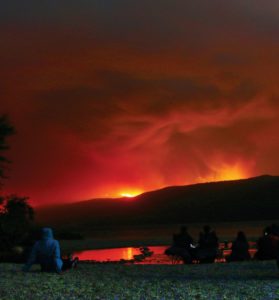
The author, Brian Schott, watched the intense Sprague Fire from the shores of Lake McDonald. Photo by Brian Schott
Yes, there will be rebirth. But there is something painful in the watching.
“Fire releases and recycles nutrients tied up in vegetation, duff, and organic soil layers,” says Lauren Alley, Glacier National Park spokesperson. “Fire stimulates plants like snowbrush and trees like lodgepole pine to release seeds. It stimulates plants like willow and aspen to grow new shoots. It also maintains age and diversity in a forest — increasing habitat for a wide range of wildlife.”
Nearly 2,000 trees now lie across the hiking trails as a result of the fire, and park officials estimate another 1,000 may fall down.
While this natural process is necessary and consistent with the area’s history, what has changed in the 20 years since my hike to fish Snyder is the ferocity of the fires — how hot many of them burn, and how many trees they kill.
“The amount of time between fires that burn a swath of landscape is about 200 to 300 years over the past 11,000 years, throughout North America, for all landscape types,” says Cristina Eisenberg, chief scientist at Earthwatch. “This wildfire return-interval is staying steady. We live in a ‘fire-prone’ and ‘fire-adapted’ system. All of the data from the Rockies and North America shows that the amount of fires is not increasing. Nor is their size. What is increasing is their severity due to climate change.”
While Sprague was a typical fire in terms of intensity, the Kenow Fire — that blew up at the same time just north in Waterton Lakes National Park — burned with 90 percent uniform high severity, which is unprecedented. That fire burned nearly 50,000 acres — much of it in a four-hour run fueled by 40 to 80 mile per hour winds, destroying the park’s visitor center, and threatening the historic Prince of Wales Hotel and townsite.
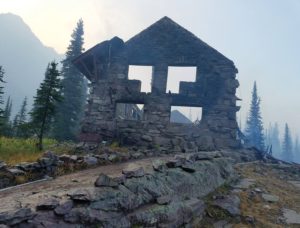
High winds, hot weather, and low relative humidity pushed the fire and destroyed the iconic main building at Sperry Chalet. Photo by Glacier National Park
Gary Ferguson, author of Land on Fire: The New Reality of Wildfire in the West (Timber Press, 2017), notes that the wildfire season today in the West is 75 days longer than it was in 1972. I ask him what he thinks wildfires will look like 25 to 50 years in the future. “In that time frame and well beyond, I see the type of fire seasons that we are experiencing will be equally severe if not more so because of the conditions leading to these seasons. This kind of general warming and drying and increases in wind events and lightning will continue for many decades to come.”
Beyond wildfires driven by climate change, the rapidly melting glaciers are a portent of the global melting to come. Early last century, about 150 glaciers clung to the rocky spires of Glacier National Park. Today, only 26 are large enough to be called such. Various models predict the glaciers will all disappear in the next several decades, with the possibility of no active glaciers by 2030.
Not only does this mean less water for the drying forests and an increase in wildfire, it will also eliminate the release of cold water in later summer when the mountain streams and native fish need it most.
On this hot September night, as we watch a giant plume of smoke shoot up like a tornado with the gusting winds, I look at my children and promise myself to at least touch the Sperry Glacier with them before too long.
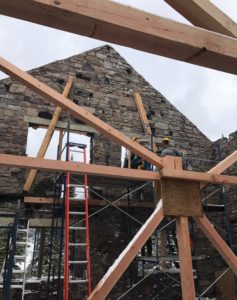
In October, crews used over 100 beams to brace walls, gables, windows, and chimneys to protect Sperry’s stone walls. Photo by Glacier National Park
I wonder how many fires they will weather in this warming world. How many fish will they catch? What echoes are reverberating now that will affect their lives forever?
Perhaps sooner than we know, Sperry Chalet will rise again. Just before winter, crews spent 12 days stabilizing the stone masonry walls to protect it from heavy winter snow and storm winds. The Glacier National Park Conservancy has launched the Sperry Action Fund to raise money for these immediate and future needs.
Secretary Ryan Zinke has pledged that the chalet will be rebuilt as one of his “top priorities,” and Senator Jon Tester suggested in January that the U.S. Capitol Christmas tree — a 79-foot-tall Engelmann spruce initially harvested from the Kootenai National Forest — be shipped back to Montana so that its timber can be used in the rebuild.
On the lakeshore tonight, watching the fire burn, I close my eyes and imagine touching the Sperry Glacier with my young children. I envision our first trip to a newly built Sperry Chalet. In my mind’s eye I see a fish rising to the first fallen ash of the Sprague Fire on the clear surface of Snyder Lake as the winds gust. And uninterested, the fish returns to the depths.




No Comments